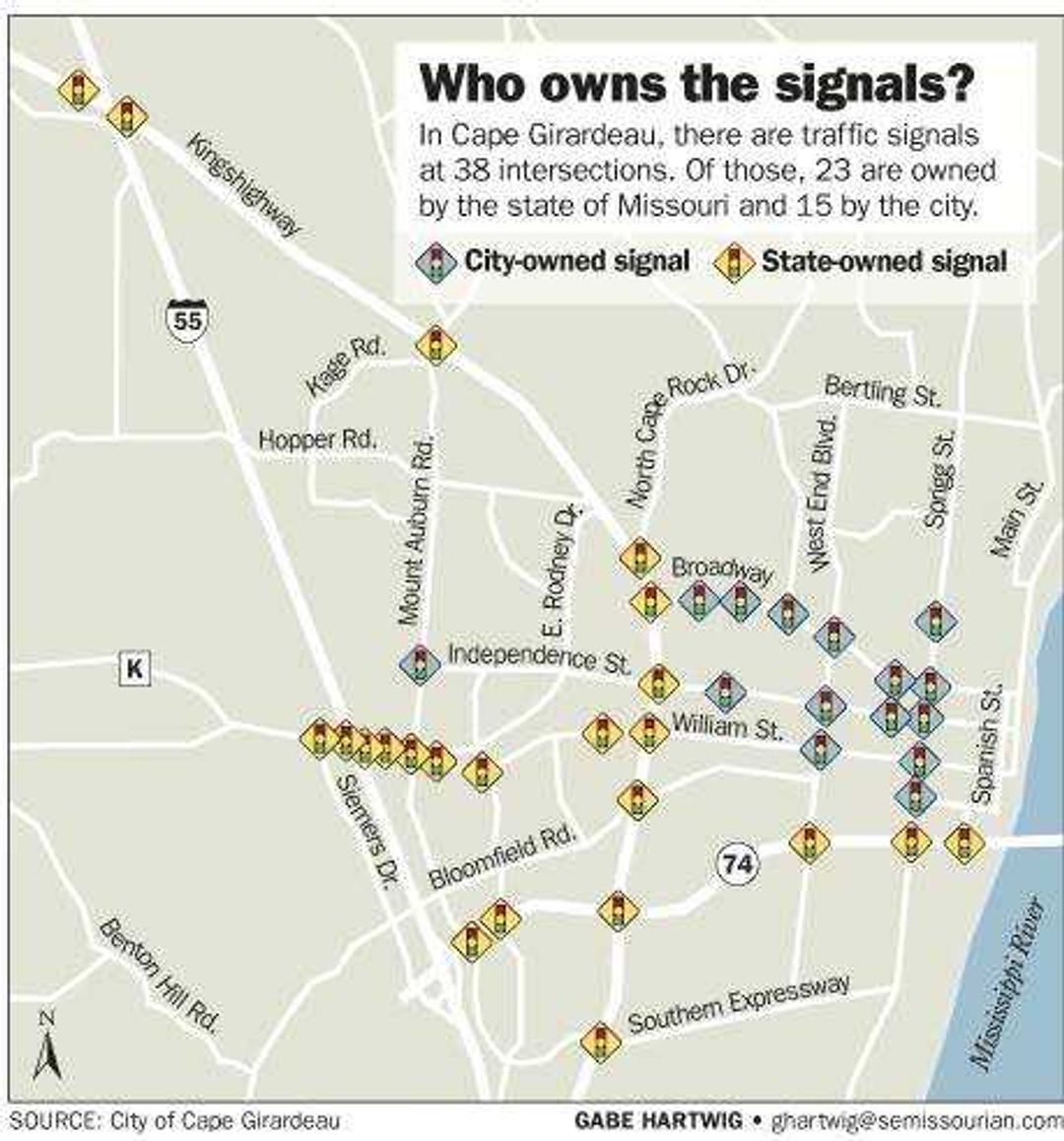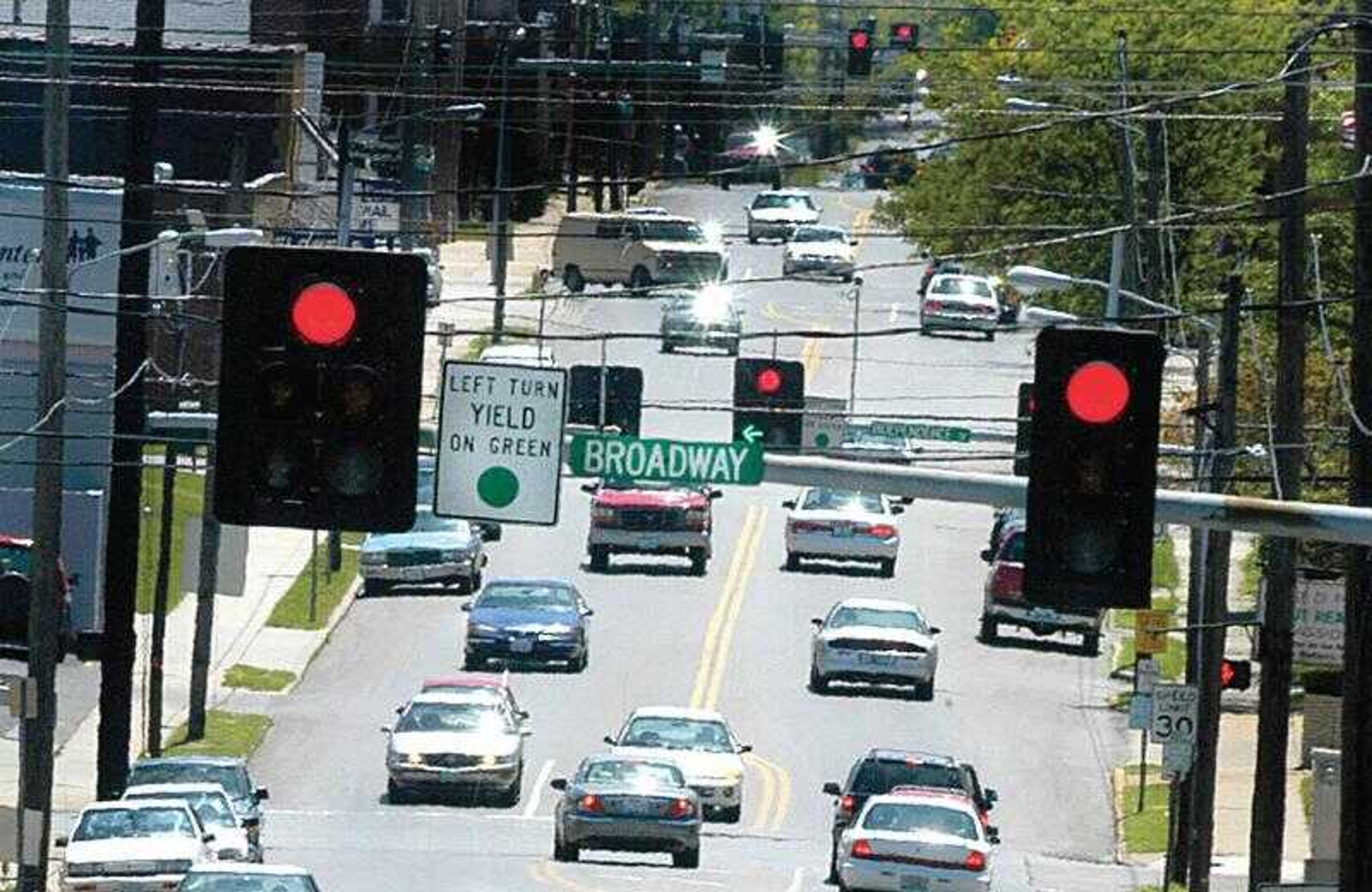Motorists may see red over a national study that gives low marks to the nation's traffic signals, but officials with the city of Cape Girardeau and the Missouri Department of Transportation say their lights aren't the problem.
Outdated and inefficient traffic signals force commuters to sit in traffic congestion, waste gasoline and pollute the air, according to the Institute of Transportation Engineers in Washington, D.C.
Two-thirds of 378 traffic agencies in 49 states don't actively monitor traffic lights, the group said.
The engineering group says ideal management of traffic signals would cut traffic delays by 15 percent to 20 percent, reduce travel time by up to 25 percent, cut vehicle emissions by as much as 22 percent and reduce gasoline consumption by up to 10 percent.
It also would cost a ton of money, an estimated $965 million a year nationwide.
But traffic officials in Cape Girardeau and with the MoDOT office in Sikeston said they have upgraded signals and made adjustments to improve traffic flow.
MoDOT says it routinely adjusts its 2,378 traffic signals, including 110 in Southeast Missouri.
There are 38 traffic signals in Cape Girardeau. MoDOT operates 23; the city has 15.

Jackson has seven traffic-signaled intersections, and Scott City has three signaled intersections. MoDOT operates all of those lights because they are all on state routes.
The city of Cape Girardeau has made major changes to its 15 traffic-signaled intersections, said public works director Tim Gramling.
"We went away from the old, mechanical, purely timed signals about five or six years ago," he said.
Because the old signals operated on 1950s-era technology, "we basically found we couldn't find parts anymore," he said.
The city has spent about half a million dollars upgrading traffic signals and control equipment, Gramling said, and plans to spend at least $150,000 more in the next five years.
The signals now are all run by computer and traffic demand. Detectors in the pavement or in overhead cameras control the traffic signals. Four of the city's 15 intersections are now controlled by cameras mounted on the signal arms.
"Overhead detection is actually cheaper," Gramling said. In-pavement detection can be interrupted by a shift in the pavement or by street construction.
The city's goal is to get all its traffic signals outfitted with cameras and wireless communication that will allow all of the traffic signals to be synchronized.
"We hope to have this done in the next five years," Gramling said.
The system already allows for traffic lights to be reprogrammed for special events like parades and ballgames to help deal with traffic flow.
Within a year, the city expects to be able to monitor and adjust traffic signals from a computer in the new public works building, Gramling said.
But even well-synchronized traffic signals won't please some motorists, he said. That's because motorists on side streets often have to wait longer at intersections while traffic on the major streets goes by.
The city plans to spend $60,000 in the 2006-2007 fiscal year to add battery power to the traffic signals so they can continue to operate during power outages, Gramling said. That way, police officers no longer would have to direct traffic during outages.
The city also wants to hire a new traffic operations manager within the next few months, filling a position that has been vacant.
While the city likes the camera-monitored signals, MoDOT still prefers using wires in the pavement to detect vehicle traffic and activate signals.
Craig Compas, traffic engineer with MoDOT's regional office in Sikeston, said his agency has found it more difficult to use cameras to detect traffic and activate signals where there are a large number of traffic lanes and turning movements at an intersection.
Most of MoDOT's signals in Southeast Missouri are traffic activated. A few signals are strictly on a timer. But Compas said that is only in areas where traffic is light.
Last year, MoDOT upgraded traffic signals on Route K from Silver Springs Road to Siemers Drive as part of major street improvements. The improvements included installation of a fiber-optic cable that connects the traffic signals at all the intersections in that area of Route K to allow motorists to move through the area without stopping at every light.
A dial-up modem allows MoDOT to adjust the traffic signals from its Sikeston office.
Meanwhile, the highway department continues to manually adjust its traffic signals on Kingshighway to allow traffic to flow better through the busy intersections.
"When dealing with eight different movements at each signal, nothing is going to be perfect," said Brad Watson, senior traffic engineering specialist with MoDOT in Sikeston.
City officials in Jackson and Scott City say they're happy to let MoDOT maintain, operate and adjust the traffic signals, and field the complaints from motorists who feel they are stuck too long in traffic.
"There's quite a lot of maintenance involved," said Scott City administrator Ron Eskew.
Jackson city engineer Dan Triller believes MoDOT's traffic signals could be better synchronized.
But he doesn't see any incentive for the federal government to fund traffic signal improvements that would reduce fuel consumption.
"You are taxed for every gallon you burn," he said. The gas tax money goes to help fund highway projects.
mbliss@semissourian.com
335-6611, extension 123
Connect with the Southeast Missourian Newsroom:
For corrections to this story or other insights for the editor, click here. To submit a letter to the editor, click here. To learn about the Southeast Missourian’s AI Policy, click here.








